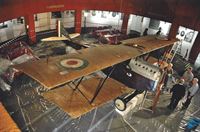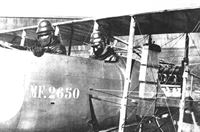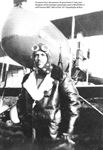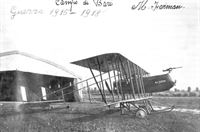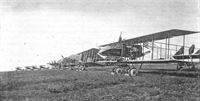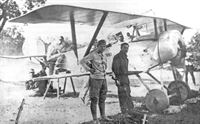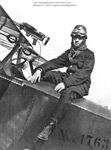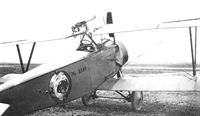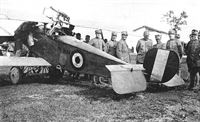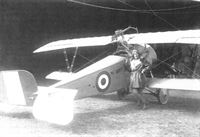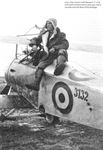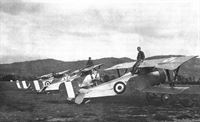Книги
Aeronaut
R.Gentilli
Italian Aviation Units in the First World War. Vol.3
443
R.Gentilli - Italian Aviation Units in the First World War. Vol.3 /Aeronaut/ (3)
Baracca poses by his 34th and final victory, Albatros D.III 153.266 of Flik 51/J, shot down on 16 June 1918. Its pilot, Ltn. Von Josipovich, survived and was captured. Baracca was well known for his chivalry and his habit of visiting downed airmen and bringing them small gifts to ease their captivity. A short four days later, Baracca himself would be shot down and killed.
Captured Lloyd 42.11 was used on operations in the 73a Squadriglia. It was probably the first instance of roundels appearing on an Italian airplane.
The Austrian seaplane Lohner L71 from Pola was captured during a large raid on Ancona on 3 April 1916. Other seaplanes took its crew to safety.
The British Felixstowe flying boats from Malta cooperated with the Italians in Libya in the fight against German submarines in the Mediterranean.
The Ansaldo Sopwith, license-built Sopwith Baby, served at many seaplane bases in Italy, including Bari, but is not known to have flown any combat missions.
A Sopwith 1A2 of the French Escadrille Espinasse in June 1917. Second from the left is Louis Weiller, an outstanding pilot and later creator of the Gnome et Rhone aircraft engine factory. The fourth one is cap. Bolognesi, commander of the 78a Squadriglia.
The Ansaldo Balilla 16553 gifted to Antonio Locatelli is now exhibited in the Museum Tino Sana in Almenno San Bartolomeo. (Courtesy Visit Bergamo)
Two Ansaldo Balilla, 16552 and 16553, decorated with St. George slaying a dragon, were donated to Locatelli and Palli; both of them survive in museums. This is Palli's 16553 at San Pelagio airfield. The castle in the background is now home to an aviation museum. (Courtesy Melley)
Italian aircraft were exhibited in New York in 1919; an Ansaldo Balilla, an SVA, and a Caproni Ca.4 triplane can be seen.
A second original SVA of the 87a Squadriglia, 11721, is preserved at the Historical Museum of the Italian Air Force at Vigna di Valle, near Rome.
A third original SVA of the 87a Squadriglia, 11777, is preserved in the Museo Aeronautico "Gianni Caproni" in Trento. Both 11721 and 11777 were modified after the war with an enlarged radiator.
SVA 6841 of the 87a Squadriglia equipped with racks for two bombs on the side of the fuselage.
The Italian SVA 5 single-seater was an excellent long-range reconnaissance plane. With a top speed of 147 mph it was the fastest WWI aircraft to see significant service.
The Italian SVA 5 single-seater was an excellent long-range reconnaissance plane. With a top speed of 147 mph it was the fastest WWI aircraft to see significant service.
Antonio Locatelli in a SVA equipped with bomb racks at Padua, in September 1918. The pilot standing is Gino Allegri. (Archive Roberto Mantiero)
Ten Natale Palli in the cockpit of his beloved SVA '11720' at San Nicolo, Venice, during his series of missions for the Navy, the same machine he flew when he perished in March 1919, during a cross-Alps flight from Padua to Paris. His natural talents for long-range aerial navigation earned him the nickname 'the flying pigeon' from his comrades at the 87a Sqa SVA, of which he became CO on 7 September 1918. Behind is a Hanriot Hd.1 of the local 241a Squadriglia. Palli died in this SVA on 20 March 1919, crashing in the Alps while trying to reach Paris.
SVA 12181 in Africa, showing an enlarged radiator. In Libya the 89a Squadriglia adopted an insignia taken from a book by d'Annunzio that reads "Altam supra volatardea nubem", the heron flies above the high cloud.
A SVA showing the Roman Eagle insignia of the Gruppo Comunicazioni Aeree getting ready for a mail flight during the strikes in 1919. The panel reads "Air mail - route Rome - Pisa - Genoa".
The pilots who flew over Vienna. From the left, Granzarolo, Allegri, Locatelli, Palli, d'Annunzio, Massoni, Finzi, Censi.
Olivari and Baracca testing one of the first SVA, a large airplane, much different from the nimble fighters that they were flying. (Archive Casirati)
Ten. Giovanni Ranucci, a veteran of the valiant 25a Squadriglia. Here he is with a SVA in a photo dedicated to Francesco Brach Papa.
Long serving pilot Gino Allegri, whom d'Annunzio called Fra' Ginepro, earned a Gold Medal, three Silver, and one Bronze medal.
Plenty of SVAs were available at Campo San Pietro for the training of SVA pilots. A civilian flying school or military pilots operated there in the Twenties.
A Nieuport 11, an Hanriot, and a Nieuport 17 of the 82a Squadriglia at Padua. In the background there are three Capronis and two SVAs of the 87a Squadriglia.
Fighters of the of the flight of the 79a Squadriglia at Nove di Bassano in early 1918, with a Ni.27 with unusual supports for a gun over the top wing, two Ni.17 and a Hanriot, in the background a SVA of the 2a Sezione.
Italian aircraft were exhibited in New York in 1919; an Ansaldo Balilla, an SVA, and a Caproni Ca.4 triplane can be seen.
An SVA 3 (the short span version of the SVA) crashed at Brindisi on 13 October 1918. Its pilot, brig. Zeppegno, later died in a crash flying for d'Annunzio in the occupied city of Fiume in 1919. (Archive De Antoni)
The SVA was donated to d'Annunzio and is preserved at Vittoriale, his villa on the Garda Lake, now a national museum.The volunteers of GAVS, Group of Friends of Historical Aircraft, are here seen planning its careful restoration.
The special SVA 12736 two-seater of d'Annunzio and Palli in a promotional visit to France, Sept. 1918. Behind is a Spad 13 of French Escadrille SPA 154.
SVA 12736 with d'Annunzio and Palli; during the flight to Vienna it did not yet carry the insignia of the Lion of St. Mark.
The SVA 12736 of d'Annunzio. The Latin motto below the Lion reads: "Iterum rudit leo", the lion roars again.
D'Annunzio posing with SVA 12736. His personal insignia showed the war flag of the Republic of Venice, the Lion has closed the book and is holding a sword. The tail was blue with the seven golden stars of Ursa Minor.
In one of the most legendary aviation feats of the war, Italian SVAs drop leaflets on Vienna on 9 August 1918. SVA Number 12736 in the foreground carried d'Annunzio in the front cockpit. It is missing its Lion of St. Mark emblem, which was applied after the flight.
Caproni 2346 of the 109a Squadriglia, here possibly after its assignment to the training airfield at Capua.
A Nieuport 11, an Hanriot, and a Nieuport 17 of the 82a Squadriglia at Padua. In the background there are three Capronis and two SVAs of the 87a Squadriglia.
Italian aircraft were exhibited in New York in 1919; an Ansaldo Balilla, an SVA, and a Caproni Ca.4 triplane can be seen.
Giorgio Pessi, a.k.a. Giuliano Parvis, in the United States, in front of a Standard-built Caproni 600 hp at Hazelhurst Field.
Hanriot Hd.1 #13244 at Valona; a Pomilio PD is in the background.
An admirable ground view of an Italian operated Hanriot HD-1, serial no Hd 13244, seen in a mid to late 1918 setting. Although slow by contemporary standards and with only a single .303-inch Vickers gun, distinctly underarmed, the Hanriot was both very agile and robust, features that clearly endeared it to the Italians to such an extent that they foresook the much faster SPAD S XIII in favour of this more nimble mount. Indeed, at the time of the Armistice in November 1918, Italy had bought no fewer than 831 of these machines, ensuring that no fewer than sixteen of the total eighteen existing Italian fighter squadrons were equipped with the Hanriot.
An admirable ground view of an Italian operated Hanriot HD-1, serial no Hd 13244, seen in a mid to late 1918 setting. Although slow by contemporary standards and with only a single .303-inch Vickers gun, distinctly underarmed, the Hanriot was both very agile and robust, features that clearly endeared it to the Italians to such an extent that they foresook the much faster SPAD S XIII in favour of this more nimble mount. Indeed, at the time of the Armistice in November 1918, Italy had bought no fewer than 831 of these machines, ensuring that no fewer than sixteen of the total eighteen existing Italian fighter squadrons were equipped with the Hanriot.
Pomilio PE 7843 and SAML 2572 of the 114a Squadriglia. This photo was probably taken at the Rubiera depot.
Pomilio PE 22039 of the 114a Squadriglia. The airman is cap. Napoleone Del Duca, commander of the XIX Gruppo to which the 114a Squadriglia belonged.
A black panther over the roundel of this Pomilio of the 112a Squadriglia, first from the right is ten. Edoardo Barbiroglio.
A souvenir photo for the fitters and mechanics of the 112a Squadriglia; ten. Barbiroglio is the first from the left.
An original piece of canvas with the black panther of the 112a Squadriglia is preserved by a reputed aviation historian. (Collection William Rabito)
The 115a Squadriglia received some Pomilios, but did not like them, and remained equipped with SAMLs until the early '20s.
A concentration of Pomilios and SAMLs of different squadrons, including the 114a, at Casoni airfield, possibly for the large mission of 7 December 1917.
At Aviano, Aviatik 474 armed with a Fiat and a Villar Perosa gun. The Salmson Canton-Unne was a radial water-cooled engine.
Aviatik 686 of the 5a Squadriglia Caccia. There was a wide variety of armament and gun mounts among the Aviatiks of the defense units.
Aviatik 1599 of the 74a Squadriglia; its serial number is very high, indicating that it was built after the production of SAMLs had already begun.
Cap. Ajmone Cat with a SAML of the 111a Squadriglia. He later became commander of the Regia Aeronautica in the war in Ethiopia and of the Italian Air Force after World War 2.
The observer ten. Raoul Simonini was from Argentina; he died in a crash on 27 February 1918 with the 120a Squadriglia.
SAML 2887, adorned with the head of a Native American chief, is believed to be the personal mount of the future ace Leopoldo Eleuteri.
Close-up of a SAML showing the eagle insignia on the fuselage and the Italian colors of green, white, and red on the nose. (Archives Zoltan Czirok)
A closer view of SAML 2522, the pilot is ten. Umberto Re, an important pioneer of aviation. (Archive De Antoni)
SAML 2567 of cap. Reboa with his personal insignia, the flag of Elba Island, where he was bom, with Napoleon's three gold bees on a red band.
Pomilio PE 7843 and SAML 2572 of the 114a Squadriglia. This photo was probably taken at the Rubiera depot.
SAMLs of the 113a Squadriglia at San Piero in Campo, SAML 2860 is adorned with a faun playing his flute.
A SAML of the 115a Squadriglia at Nove di Bassano; the tall steeples of the churches of every town in Veneto allow identification of the locality.
The dramatic view of SAML 2941 returned from combat on 18 November 1917 with its fuselage stained by the blood of s.ten. Silenzi.
The dramatic view of SAML 2941 returned from combat on 18 November 1917 with its fuselage stained by the blood of s.ten. Silenzi.
SAML S.2 2943 in Macedonia with the unit's insignia, a star with the three colors of the national roundel.
SAML 2958 of the 113a Squadriglia at Cavazzo Carnico showing an insignia with the eagle and the shield of Savoy, and non-standard large roundels over the top wings.
SAML S.2 2965 with cap. Bevagna, standing, commander of the 112a Squadriglia, and ten. Ripamonti in the cockpit. The 7 of Diamonds is the winning card in the Italian card games scopa and scopone.
SAML 3092 of the 113a Squadriglia with an individual insignia, a diamond on a card with a running fox.
SAML 4439 of a rare production batch, possibly 4439-4488, of which very little data or photos are known.
Aspirante Zamboni in a picture celebrating his victory claim over Foza on 1 January 1918. (Archive Franco Ragni)
The Minister of War General Morrone visiting the 113a Squadriglia with cap. Paroli. (Archive Franco Ragni)
Aviatik designs had an impact far beyond Germany. Above are S.A.M.L.2 aircraft of Italy's 113a Squadriglia at Villaverla; the S.A.M.L. 2, one of the more reliable and successful Italian two-seaters, was developed from the Aviatik B-type design.
The pilots and observers of the 113a Squadriglia; first is cap. Paroli, with their SAMLs that are now carrying roundels on the fuselage.
The SAMLs of the 113a Squadriglia, some of them showing camouflage on the wings, top fuselages and tails, applied in different fashions.
The 113a Squadriglia at Cividate Camuno in the summer of 1918 with three Hanriots of the fighter flight from the XXIV Gruppo (72a and 74a Squadriglia) attached to it.
The gallant serg. Pilade Nebbia in a camouflaged SAML, which unusually is equipped with a Scarff TO.3 ring for the defensive gun.
Ten. Angelo Vassalli in a SAML with an insignia on the deck of the fuselage. (Collection Mirko Sernaglia)
A SAML of the 115a Squadriglia with a personal insignia, the collar tabs of an infantry brigade, possibly the Brigata Lucca, in amaranth and white. The original caption locates the picture at Porcellengo, a village halfway between Istrana and Quinto di Treviso, where no airfield is known to be located.
A camouflaged SAML of the 115a Squadriglia with a monkey painted on its fuselage. The airplane is unarmed, and the photo may be post-war. (Archive Emiliani)
A concentration of Pomilios and SAMLs of different squadrons, including the 114a, at Casoni airfield, possibly for the large mission of 7 December 1917.
The 115a Squadriglia received in October 1918 from the 112a Squadriglia this SAML, 2524, with a unique camouflage.
The commands ordered all personal insignia to be presented for approval; some drawings have survived, like these ones for the 115a Squadriglia.
Farman MFC 2663: with the arrival at the front of new airplanes like the SIA 7B, many pusher biplanes became available for the defense flights.
Prospero Freri, the pioneer of parachutes in Italy and designer of the Salvador parachute used in World War 2, with Farman MFC 2663 of the 101a Squadriglia at Bari.
A line-up of the airplanes of the 103a Squadriglia, first an SP.2 armed with no less than ten Le Prieur rockets, then six more Savoia Pomilios and four Nieuports. The importance of the naval base at Brindisi justified these strong defenses. (Archive De Antoni)
SP.3 4509 of the 110a Squadriglia. Above the searchlight is written "Trasformato", modified, with the logo of the company that did the work. (Archives Caliaro)
D'Annunzio flying with Glenn Curtiss in Rome, September 1909, the beginning of the poet's passion for aviation.
The Hanriot of fen. Guido Baricalla captured on 15 June 1918. On the white background of the star there is the Latin motto "Alere flammam", keep high the flame. (Archives Zoltan Czirok)
Hanriot Hd.1 #13244 at Valona; a Pomilio PD is in the background.
An admirable ground view of an Italian operated Hanriot HD-1, serial no Hd 13244, seen in a mid to late 1918 setting. Although slow by contemporary standards and with only a single .303-inch Vickers gun, distinctly underarmed, the Hanriot was both very agile and robust, features that clearly endeared it to the Italians to such an extent that they foresook the much faster SPAD S XIII in favour of this more nimble mount. Indeed, at the time of the Armistice in November 1918, Italy had bought no fewer than 831 of these machines, ensuring that no fewer than sixteen of the total eighteen existing Italian fighter squadrons were equipped with the Hanriot.
An admirable ground view of an Italian operated Hanriot HD-1, serial no Hd 13244, seen in a mid to late 1918 setting. Although slow by contemporary standards and with only a single .303-inch Vickers gun, distinctly underarmed, the Hanriot was both very agile and robust, features that clearly endeared it to the Italians to such an extent that they foresook the much faster SPAD S XIII in favour of this more nimble mount. Indeed, at the time of the Armistice in November 1918, Italy had bought no fewer than 831 of these machines, ensuring that no fewer than sixteen of the total eighteen existing Italian fighter squadrons were equipped with the Hanriot.
Hanriot Hd1 19253 of the 74a Squadriglia at Castenedolo airfield, which at the end of the war was renamed Montichiari.
The pilots of 80a Squadriglia with cap. Pierro in the center, near the end of the war. Italian fighter squadrons at this time had 18 pilots, and were scheduled to have 36 in 1919.
The Hanriot Hd.1 572 of sold. Roncuzzi who got lost and landed in Switzerland. (Archive Hans-Heiri Stapfer)
Cap. Gelmetti getting out of a Hanriot with a variation of the burning star insignia, standing is ten. Ancillotto. (Archive Franz Selinger)
S.ten. Arturo Ferrarin; no confirmed victory was credited to him, but he became one of the great pilots in the history of aviation. (Archive Tebaldi)
Hanriot Hd.1 of sold. Lombardi force landed on the Adamello glacier on 19 July 1918. (Archive Ragni)
Three Hanriots of the 76a Squadriglia with a Nieuport 11 showing the heart insignia of the 77a Squadriglia.
Near the end of the war, each Hanriot of the 76a Squadriglia had a personal insignia, but some shared a cartoon character on the rudder, also from the book "Come ti erudisco il pupo”. The first one, with a white swastika, is the one of Mondini, the second one, a white owl, Pasta, the third one, cross on a shield, Sivori, the fifth one, checkerboard, Di Loreto.
Hanriot Hd.1 c/n 50 abandoned at Borgnano during the retreat.
Hanriot HD I, Nr. 50. italienisches Beuteflugzeug, erhielt später die Flugzeugnummer 00.61
Hanriot HD I, № 50. Итальянский трофейный самолет, впоследствии получивший номер 00.61.
Hanriot HD I, Nr. 50. italienisches Beuteflugzeug, erhielt später die Flugzeugnummer 00.61
Hanriot HD I, № 50. Итальянский трофейный самолет, впоследствии получивший номер 00.61.
The Hanriot of Silvio Scaroni, with his square insignia on its fuselage and tail. (Archive Achille Vigna)
Ten. Flavio Torello Baracchini of 76a Squadriglia with his brand new French-built Hanriot H.D.515 emblazoned with the four aces. H.D.6272, which he flew later, had the same personal marking. (Roberto Gentilli)
Magg. Vincenzo Lombard with his Hanriot with the insignia of Group commander. On the fuselage, where the 6 is, there is a fairing with holes, to drop bombs.
American visitors admiring the Hanriot of Tenente Mario Fucini, 78a Squadriglia, with black skulls for each of his victory claims.
The right side of a Hanriot showing the Italian, Belgian, and American flags. Presumably on the left side there were the French, British, and maybe Japanese flags.
In the final months of the war, the 78a Squadriglia introduced gaudy personal markings. This is the airplane of cpr. Severino Venier.
Antonio Riva, here with cpr. Morfino in his Hanriot, showing a red pennant. Riva was born in Shanghai, his Chinese name was <...> After the war he returned to China where he married an American girl and instructed Chinese pupils to fly. Falsely accused of being a spy, he was shot in Beijing in 1951.
Hanriots of the 78a Squadriglia at San Luca. The second one, 6212, sporting a question mark, is believed to be the airplane of ten. Amedeo Mecozzi.
HD.1 of 81a Squadriglia. The Hanriot replaced the Nieuports as the standard Italian fighter; it was more robust and had better climb and maneuverability at altitude. It still mounted only one gun, but it was synchronized.
A colorfully-marked Italian Hanriot HD.1 of S. tenente Antonio Bogliolo. The Vickers machine gun, which was originally offset, was relocated to the centerline of the fuselage in order to improve the pilot’s access to the gun in flight and make aiming easier.
A colorfully-marked Italian Hanriot HD.1 of S. tenente Antonio Bogliolo. The Vickers machine gun, which was originally offset, was relocated to the centerline of the fuselage in order to improve the pilot’s access to the gun in flight and make aiming easier.
A piglet and a child are painted on the Hanriot of s.ten. Michele Borea d'Olmo, unfortunately hiding the serial number.
Hanriots and a Ni.27 of the 81a Squadriglia at Casoni. The first Hd.1 seems to have a black shield insignia.
Fighters of the 81a Squadriglia at Casoni: the first one is Hanriot 6287 of cpr. Astolfi, the second one Hd.1 of serg. Genta, the third one is Ni.27 5836 of serg. Melloni, that fell in enemy hands on 1 May 1918.
As the fortunes of war turned for the better, the Hanriots of the 81a Squadriglia, like the ones of the sister unit 76a Squadriglia at Casoni, received ever more gaudy personal markings.
HD.1 fighters of 81a Squadriglia on their airfield. The Hanriot, some bought from France but most built under license in Italy, was the mainstay Italian fighter for the last part of the war. Italian fighter pilots valued maneuverability above all other qualities, so preferred the HD.1 to the much faster SVA 5 because the SVA was not nearly as maneuverable. The HD.1 was much more robust than the Nieuports previously used, and had better maneuverability at high altitude.
HD.1 fighters of 81a Squadriglia on their airfield. The Hanriot, some bought from France but most built under license in Italy, was the mainstay Italian fighter for the last part of the war. Italian fighter pilots valued maneuverability above all other qualities, so preferred the HD.1 to the much faster SVA 5 because the SVA was not nearly as maneuverable. The HD.1 was much more robust than the Nieuports previously used, and had better maneuverability at high altitude.
An Hanriot Hd.1 "P" of 82a Squadriglia, it is a French machine, construction number 506, its Italian military serial was 11392.
A line-up of Hanriots: the first one, serial 6649, is French-built and was the usual mount of serg. Teobaldi; next it Macchi-built 13311, marked with a small "R".
A Nieuport 11, an Hanriot, and a Nieuport 17 of the 82a Squadriglia at Padua. In the background there are three Capronis and two SVAs of the 87a Squadriglia.
A red dragon on the sides of Hanriot 7501, while three stars, green, red, and white, are painted on the top fuselage.
The Hanriots of the 85a Squadriglia received a variety of not particularly beautiful personal markings. This is Hd.1 19304.
Another version of the cartoon from the book by Oronzo Marginati. The words mean "Bring my regards to him".
Happy Hooligan was as popular on Italian airplanes in World War 1 as Donald Duck was in World War 2.
Fighters of the of the flight of the 79a Squadriglia at Nove di Bassano in early 1918, with a Ni.27 with unusual supports for a gun over the top wing, two Ni.17 and a Hanriot, in the background a SVA of the 2a Sezione.
Airplanes of the 91a Squadriglia at Padua during the retreat, November 1917. Baracca's Spad is the last of the line. Among them there are Spads, Hanriots, and Ni.27s of other units.
Seventeen Hanriots, both Italian and French-built, can be seen, equipping the 80a Squadriglia in late 1918. (Collection Fabio Bianchi)
The 113a Squadriglia at Cividate Camuno in the summer of 1918 with three Hanriots of the fighter flight from the XXIV Gruppo (72a and 74a Squadriglia) attached to it.
Nieuport 27 lineup of 83a Squadriglia in 1918. Behind these Ni.27s of the 83a Squadriglia at Poianella two Hanriots can be seen. Also one Hanriot has it back fuselage painted white.
Ten Natale Palli in the cockpit of his beloved SVA '11720' at San Nicolo, Venice, during his series of missions for the Navy, the same machine he flew when he perished in March 1919, during a cross-Alps flight from Padua to Paris. His natural talents for long-range aerial navigation earned him the nickname 'the flying pigeon' from his comrades at the 87a Sqa SVA, of which he became CO on 7 September 1918. Behind is a Hanriot Hd.1 of the local 241a Squadriglia. Palli died in this SVA on 20 March 1919, crashing in the Alps while trying to reach Paris.
Farman 887 of the 104a Squadriglia used to carry the mail; during the war there was no connection by land among the Italian-held cities in Libya.
Farman 1944 at Zuara, on the left there are two Ascari, the gallant Eritrean colonial troops. (Archive Longhi)
A Farman, probably serial 4978, of the 106a Squadriglia. On its rudder there is an inscription "Ali + ?" wings plus... (Nannarelli via Ballista)
No serial number, but a very apparent devil's head on this Farman of the 104a Squadriglia. (Zattoni via Miles)
A postcard of the airfield at Tobruk with variations of individual insignia of the Farman 883 of the 104a Squadriglia, two devil's heads and a moon.
An accident on 18 November 1915 to the Farman of capitani Degan and Parvopassu in the surroundings of Tripoli.
Nieuport 10 and 11 aircraft of the 76a Squadriglia at Santa Maria la Longa airfield. (Archive Caliaro)
Dante Nannini Sandoval was the first licensed pilot of Guatemala. He died of the Spanish flu in New York in early 1919.
A perfect replica of Alvaro Leonardi's Nieuport 2123, belonging to the Vintage Aviator Collection, is now flying at Hood Aerodrome, New Zealand. (James Fahey)
Nieuports 11s of the 76a Squadriglia: the first one, 1623, carries the name “Fringuello" (finch), the second one, 1700, with Bonavoglia, shows a Happy Hooligan, the third one, 2161 of Olivero, another comic character.
Fornagiari, Brenta, and Magistrini with Nieuport 11 1675. The 78a Squadriglia seems to have used a combination of triangles and circles for identification.
The same Nieuport 1763 now appears in natural fabric with a band in the Italian colors of green, white, and red.
Serg. Venchiarutti in a French-built Nieuport 11; 1806 (1805 ???) is its Italian serial number. (Archive Caliaro)
Variations of the Happy Hooligan cartoon adorned the Nieuports of the 80a Squadriglia until the Command forbade them. (Archive Angelo Emiliani)
Alvaro Leonardi on Nieuport 2123. A perfect replica of this fighter, belonging to the Vintage Aviator Collection, is now flying at Hood Aerodrome, New Zealand. (James Fahey)
Macchi-built Nieuport 11 2137 with the name "Terribile" written in its roundel. It has been identified as the airplane of the ace Baracchini.
The left side of Nieuport 2157 showing a roundel with the inscription "Asso?.. Macche!! Due di coppe" (An ace? Not at all! Two of clubs, that is, the lowest card.) This was possibly the airplane of commander Gordesco.
Nieuport 2174 of the 80a Squadriglia.The man in its cockpit is serg.m. Camillo Sirigatti, a reconnaissance pilot.
Baracchini, standing behind the rudder of his Nieuport 11 2179, being congratulated after scoring a victory.
Another view of Baracchini with Nieuport 2179 that shows a cartoon character painted on the deck of the fuselage.
The 80a Squadriglia turned to a more serious insignia, a simple star. This Ni.11, 2225, actually shows two stars. (Collection Carmelo Biz)
Arturo Dell'Oro rammed an enemy airplane, losing his life. The Gold Medal, Italy's highest decoration, was assigned for his heroic feat.
Andrea Teobaldi with Nieuport 2297. This gallant pilot was an instructor at the Gabardini flying school after the war. In World War 2 he piloted transport airplanes on the dangerous route from Sicily to North Africa.
A line-up of the airplanes of the 103a Squadriglia, first an SP.2 armed with no less than ten Le Prieur rockets, then six more Savoia Pomilios and four Nieuports. The importance of the naval base at Brindisi justified these strong defenses. (Archive De Antoni)
The fighters of the 76a Squadriglia. The second Ni.11 carries Le Prieur rockets, the ninth airplane is a French-built Nieuport 17.
Three Hanriots of the 76a Squadriglia with a Nieuport 11 showing the heart insignia of the 77a Squadriglia.
In this well-posed picture, a pilot points at the incoming enemy raiders, mechanics are ready to spin the propellers, and an officer is watching with a telescope.
Nieuport 10 and 11 aircraft of the 76a Squadriglia at Santa Maria la Longa airfield. (Archive Caliaro)
A Nieuport 11, an Hanriot, and a Nieuport 17 of the 82a Squadriglia at Padua. In the background there are three Capronis and two SVAs of the 87a Squadriglia.
Ten. Ernesto Bonavoglia had a long career, first with the 76a Squadriglia, culminating in the command of the 73a Squadriglia in Macedonia.
Giannino Ancillotto with the Nieuport 11 carrying the cloth from the kite balloon he destroyed on 5 December 1917.
Giannino Ancillotto with the Nieuport 11 carrying the cloth from the kite balloon he destroyed on 5 December 1917.
Personnel of the flight of the 79a Squadriglia at Padua, only the front part of the cowling is painted in green, white, and red, the rest in a light color.
A Nieuport 11 of the flight of the 79a Squadriglia at Padua, with three white bands as unit marking.
A Nieuport 11 of the 79a Squadriglia at Nove di Bassano; the steeples of the churches are useful to identify the different towns in Veneto.
This Nieuport 11 at Aiello airfield, with an ugly kid playing with a Kaiser doll and a submarine, could be either of the 77a or the 80a Squadriglia, behind it there is another Ni.11 with a red heart and the shield of Savoy.
A Nieuport tail with the cartoon "Come ti erudisco il pupo", and behind it, again the Ni.11 with the heart and the shield of Savoy.
A minor accident for a Nieuport 11 of the Sezione Nieuport in Albania; the pilot is cpr. Guido Gerard.
Baracca scored his first victories in May 1917 flying Nieuport 17 2614, showing his insignia of the black prancing horse. (Archive Lino Schifano)
Mario De Bernardi in the cockpit of a brand new French-built Nieuport 17 carrying the Vickers machine gun. (Archive Fiorenzo Longhi)
Alongside the 450 locally-built Nieuport 11s, Nieuport-Macchi also produced a follow-on batch of 150 Nieuport 17s. Seen here with its proud, young pilot is serial no Ni 3632. Note the command pennant that partially obscures the first letter of the aircraft's serial no.
Nieuport 17 3592 with an elaborate version of the star, insignia of the 80a Squadriglia. (Archive Luigino Caliaro)
All the pilots of 76a Squadriglia in front of French-built Ni.17 3130. From the left, Fanti, Olivero, Appiani, Retino, Venchiarutti, De Carolis, Olivi, Bonavoglia, Arrigoni.
Nieuport 17 3568 in Albania; in the center of the roundel there is a personal insignia, too small to be deciphered. This fighter returned to Italy and was assigned to the flying school at Busto Arsizio.
S.ten. Aldo Anesini with Nieuport 17 3132 with both a Vickers and a Lewis gun, and a roundel over the deck of the fuselage.
Sergente Giovanni Riva in a Nieuport 17 showing the simple markings of the 78a Squadriglia, a pennant.
The Nieuport 17 of Tesei. The caption says: "It raised the wrath of the Supreme Command for the innocent good luck charm painted on the rudder."
Serg. Cerutti, wearing a woman's stocking as a hat, and serg. Imolesi in front of a Nieuport 17, that is armed with just a Lewis; the Vickers gun is missing.
Sergente Imolesi in a Nieuport 17 adorned with a horse shoe. This fighter is fitted with a Vickers and a Lewis gun.
General Di Robilant, commander of the 4a Armata, visiting the 2s Sezione, 83a Squadriglia, at San Pietro in Campo.
Pilots with a French-built Nieuport 17. The Vickers machine gun is not fitted, there is a Lewis gun on the top wing.
The fighters of the 76a Squadriglia. The second Ni.11 carries Le Prieur rockets, the ninth airplane is a French-built Nieuport 17.
A Nieuport 11, an Hanriot, and a Nieuport 17 of the 82a Squadriglia at Padua. In the background there are three Capronis and two SVAs of the 87a Squadriglia.
Fighters of the of the flight of the 79a Squadriglia at Nove di Bassano in early 1918, with a Ni.27 with unusual supports for a gun over the top wing, two Ni.17 and a Hanriot, in the background a SVA of the 2a Sezione.
Nieuport 17s of the 3a Sezione. The third airplane, 3619, seems to have a darker color on the top wing.
A ceremony for the award of medals at Aiello airfield, probably on 2 October 1917, with an apparently new Nieuport 17 of 80a Squadriglia. The Duke of Aosta, commander of the 3a Armata, is in the center, with crossed arms, to his right Gen. Maggiorotti and to his left Col. Moizo, of the air force command. It is remarkable that after two and a half years of war so few medal ribbons are to be seen.
Ten. Rino Corso Fougier, who became commander of the Italian Air Force in 1941, with Nieuport 27 19779.
Nieuport 27 at Ganfardine; the individual number 6 is in the style of Escadrille N 82 that operated in Italy, possibly given to the Italians after their return to France. (Archive Achille Vigna)
Nieuport 27 with a personal insignia. This picture was identified as the airplane of serg. Cerutti, but it is not necessarily so.
Nieuport 27 5820 of the 74a Squadriglia. Its insignia was a white circle with the initials of the king, VE, and the royal emblem, the "knot of Savoy".
The same airplane on its right side showed a horseshoe, but the horse's head had not been painted yet. (Archive Jan Zahalka)
The Nie.27 was also used by the Italian 81a Squadriglia, and N5800 was one of its aircraft. It is here seen after being raptured intact, with crosses patees roughly painted over the roundels.
The Nieuport 27 5800 of serg. Rettori that fell in German hands on 15 January 1918. (Archive Jan Zahalka)
The Nieuport 27 5800 of serg. Rettori that fell in German hands on 15 January 1918. (Archive Jan Zahalka)
Fighters of the of the flight of the 79a Squadriglia at Nove di Bassano in early 1918, with a Ni.27 with unusual supports for a gun over the top wing, two Ni.17 and a Hanriot, in the background a SVA of the 2a Sezione.
Nieuport 27 N5857 heading a 79a Squadriglia lineup. The Nieuports were replaced by the more robust Hanriot HD.1 that eliminated the single-spar lower wing of the Nieuports. Although the Hanriot retained the single gun of the Nieuports, it had better climb-rate and maneuverability than the Nieuport at altitude.
Nieuport 27 N5857 heading a 79a Squadriglia lineup. The Nieuports were replaced by the more robust Hanriot HD.1 that eliminated the single-spar lower wing of the Nieuports. Although the Hanriot retained the single gun of the Nieuports, it had better climb-rate and maneuverability than the Nieuport at altitude.
Fighters of the 81a Squadriglia at Casoni: the first one is Hanriot 6287 of cpr. Astolfi, the second one Hd.1 of serg. Genta, the third one is Ni.27 5836 of serg. Melloni, that fell in enemy hands on 1 May 1918.
Hanriots and a Ni.27 of the 81a Squadriglia at Casoni. The first Hd.1 seems to have a black shield insignia.
A line-up of Nieuport 27 fighters of the 79a Squadriglia with the insignia of the she-woIf. The fourth one carries the monogram VM, for pilot Vittorio Melloni, the seventh one FPF for Francesco Pagnani Fusconi.
Another striped Ni.27 of the 83a Squadriglia. The red diamond remained as unit insignia until 1927. (Collection Mario Bobbio)
Nieuport 27s of the 83a Squadriglia, showing the unit's insignia, a red diamond, and white paint on the rear fuselage. (Archive Luigino Caliaro)
Nieuport 27 lineup of 83a Squadriglia in 1918. Behind these Ni.27s of the 83a Squadriglia at Poianella two Hanriots can be seen. Also one Hanriot has it back fuselage painted white.
A beautifully decorated Nieuport 27, "Jane" of the 73a Squadriglia in Macedonia.
In 1918, the Italian Air Force sent two squadrons to the Orient Front, the 73a (fighter) and 111a (reconnaissance) Squadriglia. Here, Nieuport 27s of the 73a Squadriglia. (Coll. Paolo Varriale)
In 1918, the Italian Air Force sent two squadrons to the Orient Front, the 73a (fighter) and 111a (reconnaissance) Squadriglia. Here, Nieuport 27s of the 73a Squadriglia. (Coll. Paolo Varriale)
Airplanes of the 91a Squadriglia at Padua during the retreat, November 1917. Baracca's Spad is the last of the line. Among them there are Spads, Hanriots, and Ni.27s of other units.
Nieuport 27 5836 that fell in Austrian hands on 1 May 1918 had a beautiful insignia with a horseshoe and a horse's head on its left side.
A crashed Nieuport 27 in Macedonia. Its serial number, 5863, confirms that it is an airplane of the 73a Squadriglia.
Spad 7 2489 flown by the ace is preserved in the Francesco Baracca Museum in his hometown, Lugo fi Romagna.
The historical Museum of the Italian Air Force at Vigna di Valle shows a Spad with the colors of Ruffo. After the war, many fighters were gifted to the top aces, and many of them have survived.
Paola Ruffo di Calabria, queen of the Belgians until 2013, visiting the Spad of her father in the Italian Air Force Museum.
Two Spads survive in Italy with the colors of Cabruna: his original one, in the Italian Air Force Museum in Vigna di Valle, and another original Spad, in the Officers School of the Carabineri in Rome.
Serg. Luigi Mancini flew with the 102a Squadriglia. Here he is pictured in a post-war photo that is a puzzle, showing a Spad with an insignia, "Cacciatori del Grappa", fighters of Mount Grappa, that refers to the VI Gruppo, 76a and 81a Squadriglie. Behind it, a Spad of 91a Squadriglia.
Pilots of the 76a Squadriglia with a Spad 7: from the left, Retino, unknown, De Carolis, Olivi, Bonavoglia. The serial is either 4690 or 4696. (Archive Caliaro)
The Spad of Cabruna, showing his emblem, the shield of the city of Cortona, and little iron crosses on the fuselage deck, marking his victories.
Airplanes of the 91a Squadriglia at Padua during the retreat, November 1917. Baracca's Spad is the last of the line. Among them there are Spads, Hanriots, and Ni.27s of other units.
Spad "Paquita" of the 73a Squadriglia had as emblem a prancing lion with his paw over a German spiked helmet.
The special SVA 12736 two-seater of d'Annunzio and Palli in a promotional visit to France, Sept. 1918. Behind is a Spad 13 of French Escadrille SPA 154.
Pilots of the 91a Squadriglia with the final Spad 13 of prince Ruffo, with a new form of black skull.
Magg. Baracca and ten. Ranza in front of the latter's Spad carrying the insignia of the ladder that he had taken up in memory of Sabelli.
An official photo of the pilots of the 91a Squadriglia in the late spring of 1918. From the left: D'Urso, Aliperta, Novelli (hiding Magistrini), Costantini, Ruffo di Calabria, Piccio, Keller, Baracca, Ranza, Bernardi, Bacula, Nardini, and Olivero.
Voisin 1322 of the 105a Squadriglia, here pictured on a visit to the flying school of San Giusto, Pisa.
Voisin 2087 of the 103a Squadriglia with the crew of gunner sold. Dario Mazzarella and pilot serg. Arturo Foa.












































